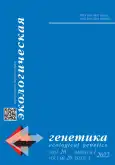Analysis of mutation frequencies of the BRCA1 5382insC and BRCA2 6174delT genes in the population of Ufa city
- Authors: Tselousova O.S.1, Ovsyannikova L.B.1, Stepanov E.G.2,3
-
Affiliations:
- Bashkir State Medical University
- Ufa Research Institute of Occupational Medicine and Human Ecology
- Ufa State Petroleum Technological University
- Issue: Vol 20, No 1 (2022)
- Pages: 41-47
- Section: Human ecological genetics
- Submitted: 26.07.2021
- Accepted: 18.03.2022
- Published: 20.05.2022
- URL: https://journals.eco-vector.com/ecolgenet/article/view/76465
- DOI: https://doi.org/10.17816/ecogen76465
- ID: 76465
Cite item
Abstract
BACKGROUND: Currently, there is an acute problem of assessing the real genetic danger and the impact of environmental pollution on human health. One of the cities that is affected by the whole complex of anthropogenic mutagenic factors is Ufa (Republic of Bashkortostan).
AIM: The aim of the study was to analyze the frequency of pathogenic mutations in the BRCA1 5382insC and BRCA2 6174delT genes in healthy residents of an industrial city.
MATERIALS AND METHODS: The mutations were determined by real-time PCR using the TaqMan probe technology on the Bio-Rad CFX96 device (Bio-Rad, USA) in accordance with protocol in 379 DNA samples of healthy residents of average age (18.32 ± 0.45 years).
RESULTS: The total mutations frequency in the BRCA1 and BRCA2 genes reached 4.22% (n = 16). The highest frequency of mutant alleles in the BRCA1 and BRCA2 genes of 6.18% (n = 11) was present in residents of the 1 observation area, where petrochemical production enterprises are concentrated. The mutant homozygous genotype of the BRCA2 gene was detected in 3.37% of cases only among residents of the 1 observation area (n = 6, p = 0.0002). The risk of formation of mutations in the BRCA2 gene is 6 times higher in residents of the 1 observation area (χ2 = 7.75; df 1; p = 0.006; OR 6.31; 95% CI 1.44–27.67).
CONCLUSIONS: The frequency of the BRCA family genes varies depending on the studied region, the degree of environmental pollution and the studied group.
Keywords
Full Text
About the authors
Olga S. Tselousova
Bashkir State Medical University
Author for correspondence.
Email: Olga.tselousova@gmail.com
ORCID iD: 0000-0002-9124-9340
SPIN-code: 3912-5213
Scopus Author ID: 35072340800
Cand. Sci. (Biol.), Associate Professor
Russian Federation, UfaLyudmila B. Ovsyannikova
Bashkir State Medical University
Email: Ovsyannikova-mpd@mail.ru
ORCID iD: 0000-0001-5233-1942
SPIN-code: 2048-4767
Dr. Sci. (Med.), Professor
Russian Federation, UfaEvgeny G. Stepanov
Ufa Research Institute of Occupational Medicine and Human Ecology; Ufa State Petroleum Technological University
Email: doctorse@mail.ru
ORCID iD: 0000-0002-1917-8998
SPIN-code: 5386-8869
Cans. Sci. (Med.), Associate Professor
Russian Federation, Ufa; UfaReferences
- Ingel FI. Part 2. Environmental Factors and Individual Features in System of Evaluation of Human Genome Instability. Additional Capability of the Test The Technique For Cytogenetic Analysis. Ecological genetics. 2006;4(4):38–54. (In Russ.) doi: 10.17816/ecogen4438-54
- Mylavarapu S, Das A, Roy M. Role of BRCA Mutations in the Modulation of Response to Platinum Therapy. Front Oncol. 2018;8:16. doi: 10.3389/fonc.2018.00016
- Tan SLW, Chadha S, Liu Y, et al. A class of environmental and endogenous toxins induces BRCA2 haploinsufficiency and genome instability. Cell. 2017;169(6):1105–1118.e15. doi: 10.1016/j.cell.2017.05.010
- Maxwell KN, Domchek SM, Nathanson KL, Robson ME. Population frequency of germline BRCA1/2 mutations. J Clin Oncol. 2016;34(34):4183–4185. doi: 10.1200/jco.2016.67.0554
- Rebbeck TR, Friebel TM, Friedman E, et al. Mutational spectrum in a worldwide study of 29,700 families with BRCA1 or BRCA2 mutations. Hum Mutat. 2018;39(5):593–620. doi: 10.1002/humu.23406
- Connor F, Bertwistle D, Mee PJ, et al. Tumorigenesis and a DNA repair defect in mice with a truncating BRCA2 mutation. Nat Genet. 1997;17:423–430. doi: 10.1038/ng1297-423
- Zeinomar N, Oskar S, Kehm RD, et al. Environmental exposures and breast cancer risk in the context of underlying susceptibility: A systematic review of the epidemiological literature. Environ Res. 2020;187:109346. doi: 10.1016/j.envres.2020.109346
- Upravlenie Federal’noi sluzhby po nadzoru v sfere zashchity prav potrebitelei i blagopoluchiya cheloveka po Respublike Bashkortostan. Gosudarstvennyi doklad o sostoyanii prirodnykh resursov i okruzhayushchei sredy Respubliki Bashkortostan v 2020 godu. Ufa: Samrau, 2021. 287 p. (In Russ.)
- Upravlenie Federal’noi sluzhby po nadzoru v sfere zashchity prav potrebitelei i blagopoluchiya cheloveka po Respublike Bashkortostan. Materialy k gosudarstvennomu dokladu “O sostoyanii sanitarno-ehpidemiologicheskogo blagopoluchiya naseleniya v Rossiiskoi Federatsii v 2019 godu” po Respublike Bashkortostan. Ufa: Upravlenie Federal’noi sluzhby po nadzoru v sfere zashchity prav potrebitelei i blagopoluchiya cheloveka po Respublike Bashkortostan, 2020. 262 p. (In Russ.)
- Berdina LM, Khusnutdinova EK. Frequency of chromosome aberrations in the population of the Republic of Bashkortostan. Uchenye Zapiski Kazanskogo Universiteta. Seriya Estestvennye Nauki. 2006;148(3):189–196. (In Russ.)
- Tselousova OS, Ovsyannikova LB. Kompleksnaya gigienicheskaya otsenka ehkologo-geneticheskogo riska zdorov’yu naseleniya promyshlennogo goroda. ХII all-Russian science conference “Zdorov’e cheloveka v XXI veke”; 2020 Oct 28–29; Kazan. P. 242–245. (In Russ.)
- Kochetova OV, Gainullina MK, Victorova TV. Polymorphism of DNA repair genes (XRCC1, XRCC3, XPD, XPC) and risk of uterine myoma among women working in petrochemical complex. Ecological genetics. 2011;9(4):43–51. (In Russ.) doi: 10.17816/ecogen9443-51
- Bermisheva MA, Zinnatullina GF, Gilyazova IR, et al. Prevalence of BRCA1 c.5161C>T mutation in cancer patients from Bashkortostan. Advances in molecular oncology. 2021;8(4):84–93. (In Russ.) doi: 10.17650/2313-805X-2021-8-4-84-93
- Grijbovsky AM. Analysis of nominal data (independents observations). Ecological genetics. 2008;6:58–68. (In Russ.)
- Fox N, Hunn A, Mathers N. Sampling and sample size calculation. Yorkshire & the Humber: The NIHR RDS for the East Midlands, 2007. 41 p.
- Narkevich AN, Vinogradov KA. Methods for determining the minimum required sample size in medical research. Social aspects of population health. 2019;65(6):10. (In Russ.) doi: 10.21045/2071-5021-2019-65-6-10
- Collins JM, Isaacs C. Management of breast cancer risk in BRCA1/2 mutation carriers who are unaffected with cancer. Breast J. 2020;26(8):1520–1527. doi: 10.1111/tbj.13970
- Galinskaya TV, Schepetov DM, Lysenkov SN. Prejudices against microsatellite studies and how to resist them. Russian Journal of Genetics. 2019;55(6):617–632. (In Russ.) doi: 10.1134/S0016675819060043
Supplementary files










